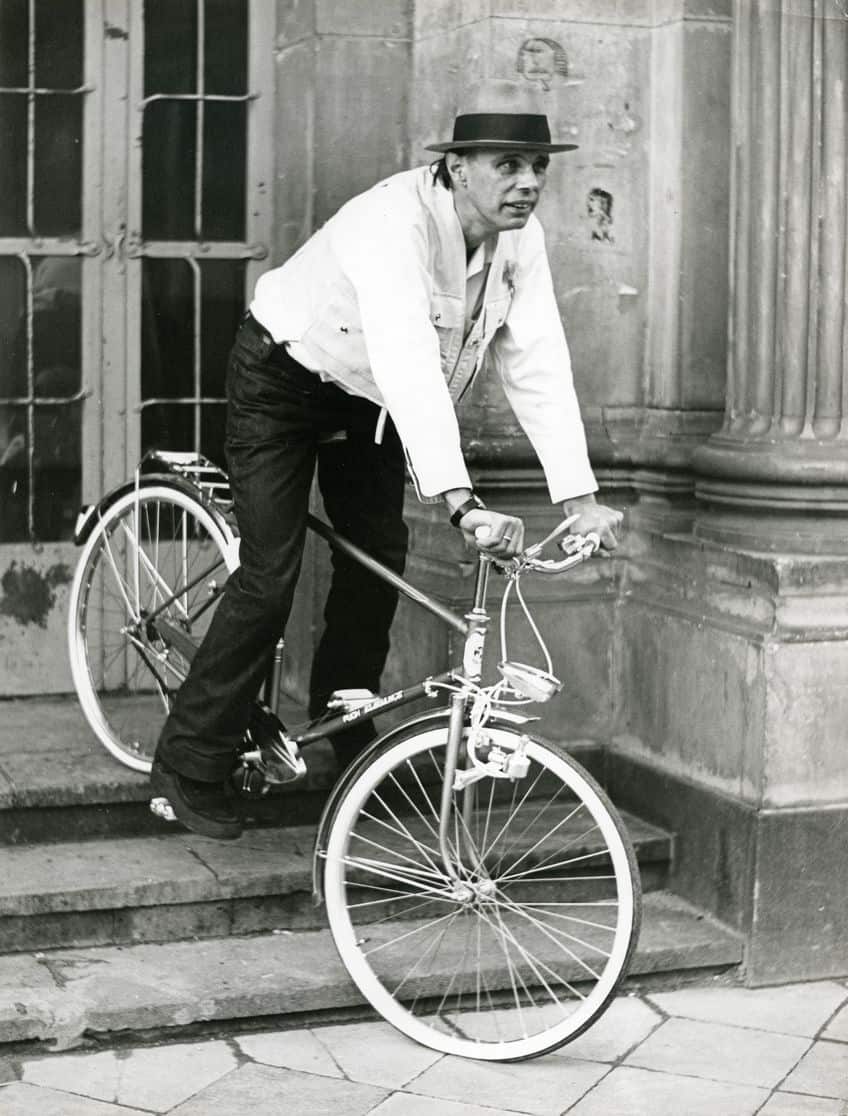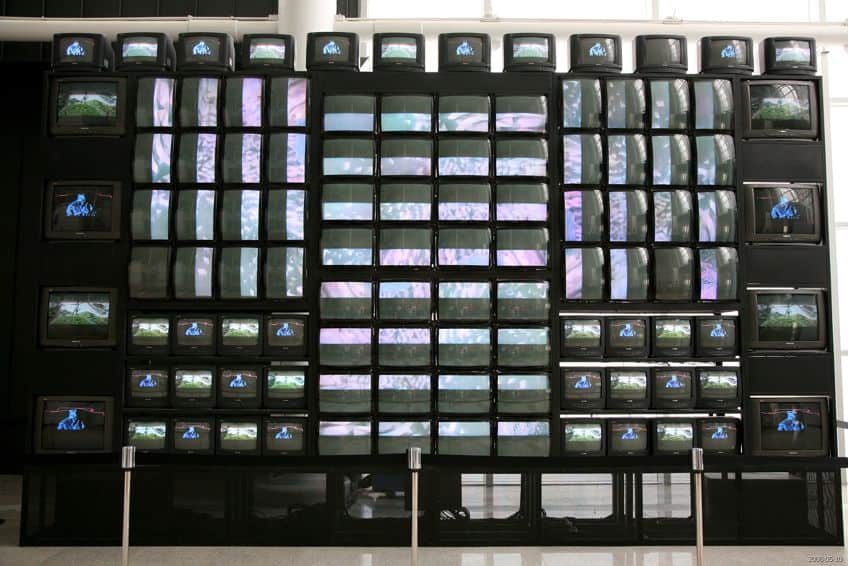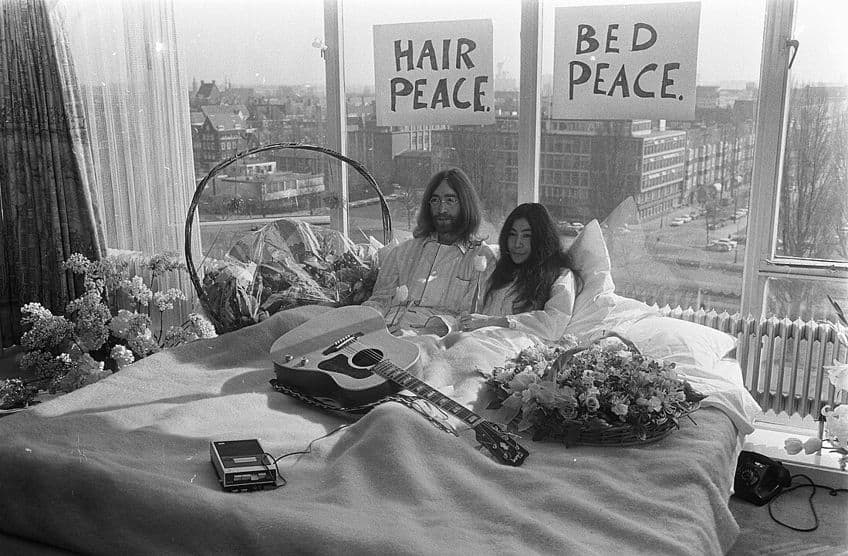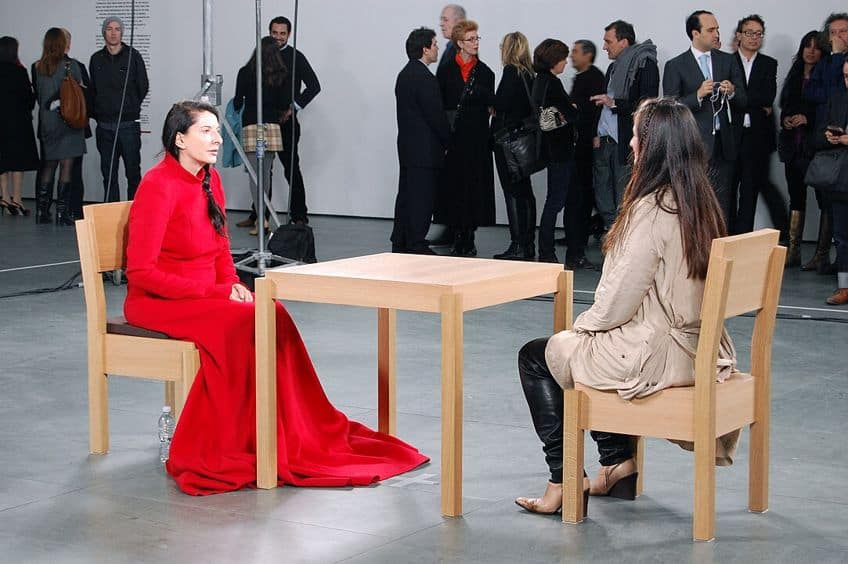Famous Performance Artists – Our List of the Top 10
What is performance art, and what is a performance artist? Perhaps one of the most creative and freeing art forms of all time, performance art history has provided us with many unique and unforgettable art pieces that left the 21st century open to exploring new notions of the role of art in enabling art access to the public. In this article, we will explore the world of performance art through a selection of the top 10 most famous performance artists of all time. Keep reading to discover the key faces of performance art!
Contents
- 1 An Introduction to Performance Art
- 2 The Top 10 Most Famous Performance Artists
- 2.1 Joseph Beuys (1921 – 1986)
- 2.2 Nam June Paik (1932 – 2006)
- 2.3 Yoko Ono (1933 – Present)
- 2.4 Marina Abramović (1946 – Present)
- 2.5 Ana Mendieta (1948 – 1985)
- 2.6 Adrian Piper (1948 – Present)
- 2.7 Tehching Hsieh (1950 – Present)
- 2.8 Nick Cave (1959 – Present)
- 2.9 Ron Athey (1961 – Present)
- 2.10 Tania Bruguera (1968 – Present)
- 3 Frequently Asked Questions
An Introduction to Performance Art
What is performance art, and what is a performance artist? You may have seen artists actively involve themselves in art events and shows that seem to revolve around audience participation or invite the viewer to simply observe the event. Art that is built on actions and other participants in an art space is what is known as performance art. When understanding the definition of performance art, it is key to identify that performance can involve the live or documented events that are presented to a public audience in an art setting. Performance can also encompass interdisciplinary elements and has historically been associated with the terms “artistic action” and “happenings”. This avant-garde art form was one of the most revolutionary forms of expression that emerged in the 20th century as a formal art form.

The term “performance art” emerged around the 1970s while its origin as an early 20th-century art form is thought to have emerged around the 1910s with the history of Futurism and cabaret performances. In 1916, the art form was also identified closely with the movement Dadaism, with scholars pinpointing its origins alongside Constructivism and Russian Futurists. In the East, action art or performance happenings emerged as the Japanese art form called gutai, which originated in 1955 in the Kansai region. Throughout the 1960s and 1970s, performance art was closely associated with environmental and land art, which bridged the gaps between sculpture and architecture.
The characteristics of performance art also include five specific elements, namely: space, time, the body, the artist’s presence, and the relationships that become evident between the audience and the art. Performances usually occur within an art space such as a gallery or museum while in some cases, performance artists choose to work in a site-specific area that adds to the theme of the artwork. Most performances aim to create a reaction or understanding with the viewer by communicating the messages through various actions and techniques such as improvisation.
Popular themes in performance art have also exposed the body as a part of art production that draws on the artist’s personal experiences and social criticism.
The Top 10 Most Famous Performance Artists
What makes performance art so incredible is its ability to transition seamlessly across art movements, as a medium that is perhaps the most effective when it comes to bringing art to life. Below, we will dive into the top 10 most famous performance artists to date, who have brought a unique edge to the art form across multiple movements.

Joseph Beuys (1921 – 1986)
| Name | Joseph Heinrich Beuys |
| Date of Birth | 12 May 1921 |
| Date of Death | 23 January 1986 |
| Nationality | German |
| Associated Movements, Themes, and Styles | Modern art, Fluxus, Conceptual art, Neo-Dada, anthroposophy, sociology, and Humanism |
| Mediums | Performance, art theory, drawing, installation, sculpture, and painting |
| Famous Artworks | ● Fat Corners (1960) ● Fat Chair (1964) ● How to Explain Pictures to a Dead Hare (1965) ● Feet Washing (1971) |
Perhaps one of the most celebrated performance artists of the 20th century, Joseph Beuys was a prolific member of the Fluxus movement, who held his first signature performance titled How to Explain Pictures to a Dead Hare in 1965.
Seemingly morbid and ritualistic, Beuys’ performance earned him significant recognition in the art world, and was also known to incorporate materials like animal fat into his conceptual pieces.
His work was also a testament to his spiritual views as he emphasized materials that would also be seen as life-sustaining elements. Beuys was a strong advocate of unconventional techniques and approaches to art education since he also believed that anyone should be able to attend art schools and practice art. He was also recognized for abolishing all requirements for entry into his classes at the Staatliche Kunstakademie Düsseldorf, where he studied and taught.

Nam June Paik (1932 – 2006)
| Artist Name | Nam June Paik |
| Date of Birth | 20 July 1932 |
| Date of Death | 29 January 2006 |
| Nationality | Korean-American |
| Associated Movements, Themes, and Styles | Modern art, Fluxus, Contemporary art, and new media art, consumerism, and technology |
| Mediums | Performance art, installation, sculpture, and video art |
| Famous Artworks | ● Hommage à John Cage (1959) ● Simple, Zen for Head and Étude Platonique No. 3 (1961) ● Magnet TV (1965) ● Opera Sextronique (1967) ● TV Bra for Living Sculpture (1969) |
Nam June Paik was regarded as one of the most famous late-20th century performance artists, who championed works such as Electronic Superhighway: Continental U.S., Alaska, Hawaii (1995) and established a term known as the “electronic superhighway”.
Nam June was a key figure in the Fluxus movement and led many avant-garde performances alongside figures like John Cage.
His performances have been described as erratic and genius in their use of musical compositions. His contribution is unmatched as he was also credited with creating a new art form in new media that highlighted the television as a tool and instrument to be interacted with. Works such as Magnet TV were performed in 1965 and invited viewers to alter the television’s output by creating abstract lines using a magnet drawn across the TV. Other captivating performances by Nam June include Hommage à John Cage (1959) and TV Bra for Living Sculpture (1969).

Yoko Ono (1933 – Present)
| Name | Yoko Ono |
| Date of Birth | 18 February 1933 |
| Nationality | Japanese |
| Associated Movements, Themes, and Styles | Modern art, Contemporary art, peace activism, multi-media art, Neo-Dada, Conceptual art, and Feminism |
| Mediums | Performance art, filmmaking, and songwriting |
| Famous Artworks | ● Cut Piece (1964) ● Bag Piece (1964) ● Ceiling Painting (1966) ● Eye Blink (1966) ● Onochord (2004) |
Famous performance artist Yoko Ono is one of the most iconic artists of the Modern and Contemporary eras, whose unique performances have left a lasting impression on the art world.
Ono’s performances have been identified as Neo-Dada works that express feminist themes in relation to the treatment of the feminine body.
Ono’s works are also conceptual and diaristic, which makes her work profound in an autobiographical sense. Through affect, agency, and aura, Yoko Ono also draws inspiration from her private life and relationship with her late husband John Lennon to present curated visual essays and short narrative texts as part of her performances. Through her real-time and filmed performances, Yoko Ono captured moments of her life and leveraged them as a form of personal public activism, which she described as her “mind worlds”.

Marina Abramović (1946 – Present)
| Name | Marina Abramović |
| Date of Birth | 30 November 1946 |
| Nationality | Serbian |
| Associated Movements, Themes, and Styles | Modern art, Contemporary art, Feminism, body art, endurance art, and spirituality |
| Mediums | Performance art |
| Famous Artworks | ● Rhythm 0 (1974) ● Expansion in Space (1977) ● Death Self (1977) ● Rest Energy (1980) ● The Artist Is Present (2010) |
Marina Abramović is perhaps one of the best 21st-century performance artists, whose unique and evocative works have truly left an impact on the genre of performance.
Abramović is recognized for her public performances which traverse themes of identity, love, endurance, spirituality, feminism, and audience engagement.
Her works are experimental and usually test the limits of her own body with works that make viewers question the boundaries between art and the observer. Abramović has been known to risk her life in her art since her work strongly tends towards reaching a higher level of consciousness and transcendence through physically and mentally strenuous acts. Performances such as Rhythm 0 (1974) brought a new meaning to performance art and established Abramović as a key player in driving meaningful works that make people question the nature of the society we live in.

Ana Mendieta (1948 – 1985)
| Name | Ana Mendieta |
| Date of Birth | 18 November 1948 |
| Date of Death | 8 September 1985 |
| Nationality | Cuban-American |
| Associated Movements, Themes, and Styles | Modern art, Feminism, body art, earth-body art, identity, and post-war art |
| Mediums | Performance, sculpture, and painting |
| Famous Artworks | ● Death of a Chicken (1972) ● Untitled (Rape Scene) (1973) ● Untitled (People Looking at Blood, Moffit) (1973) ● Body Tracks (1974) ● Untitled (Blood and Feathers #2) (1974) |
Ana Mendieta was one of the most influential performance artists of all time, whose signature earth-body works have gone on to redefine land and body art since the beginning of the Contemporary period.
Mendieta’s performance works are ritualistic and touch on themes such as trauma, sexuality, racism, abuse, death, and womanhood.
A powerful feminist artist, Mendieta’s contribution to performance is immense in her use of the personal as a powerful agent for highlighting important issues. The famous Cuban-American artist also explores feminist mysticism and its relationship to the earth via organic materials and her engagement with the elements of nature to affirm her place in the world and demonstrate, through her interaction with nature, her return to Mother Earth.
Adrian Piper (1948 – Present)
| Name | Adrian Margaret Smith Piper |
| Date of Birth | 20 September 1948 |
| Nationality | American |
| Associated Movements, Themes, and Styles | Modern art, Contemporary art, Conceptual art, Feminism, otherness, ostracization, class, gender, identity, spirituality, philosophy, and race |
| Mediums | Performance, photography, sculpture, and drawing |
| Famous Artworks | ● Catalysis III (1970 – 1971) ● Mythic Being (1973 – 1975) |
Another iconic performance artist is Adrian Piper, who is also a famous Conceptual artist and philosopher. Piper’s work explores her experience of Black identity as a woman, who faced different forms of otherness for her light skin and straight hair, and left her in a position of being perceived as “not Black enough”.
Piper is celebrated for her New York performances, where she tested the psychology of the public through various public appearances and unusual actions.
One of her most well-known pieces was her 1970 performance Catalysis, which saw the artist dress in clothing that was foul smelling and move around the city to evoke different responses in people, from book shops to the subway. Her work is a testament to the 1970s art styles of Conceptual performance art that inspired many women to contest conventional art practices.
 What It’s Like, What It Is (1991) by Adrian Piper; Adrian Piper, CC BY-SA 3.0, via Wikimedia Commons
What It’s Like, What It Is (1991) by Adrian Piper; Adrian Piper, CC BY-SA 3.0, via Wikimedia Commons
Tehching Hsieh (1950 – Present)
| Name | Tehching Hsieh |
| Date of Birth | 31 December 1950 |
| Nationality | Taiwanese-American |
| Associated Movements, Themes, and Styles | Contemporary art |
| Mediums | Performance and painting |
| Famous Artworks | ● Jump Piece (1973) ● Cage Piece (1978 – 1979) ● One Year Performance 1980–1981 (Time Clock Piece) (1980 – 1981) |
Renowned Taiwanese-American performance artist Tehching Hsieh is recognized as a master of performance art by many of his contemporaries.
Widely known for his somewhat extreme approach to performance, which artists like Marina Abramović admired, Hsieh’s work is poignant as he fully dedicates his life and body to fulfilling his artistic intentions.
One of his most impactful performances was Outdoor Piece, which saw Hsieh spend a total of 8,760 hours outdoors, 15 hours of which he spent detained due to his position as an undocumented immigrant. While this slightly hindered his artistic concept, Hsieh continued to create many powerful performances that speak to hate crimes, immigrant experiences, and racism toward Asian people in America.

Nick Cave (1959 – Present)
| Name | Nick Cave |
| Date of Birth | 4 February 1959 |
| Nationality | American |
| Associated Movements, Themes, and Styles | Contemporary art, fabric art, found objects, class, race, gender, identity, African art, and metaphorical armor |
| Mediums | Performance, sculpture, assemblage, and dance |
| Famous Artworks | ● Soundsuits series (1992 – Present) ● HEARD•NY (2013) |
Famous Contemporary performance artist Nick Cave is one of the most fascinating performance artists of the decade, whose seminal Soundsuits series has captured the global art world since 1992.
Cave is recognized for his politically charged and culturally driven artworks.
His series Soundsuits was initially created to respond to the horrific beating of Rodney King, who was a victim of police brutality in 1991. From installation to sculpture and performance, Cave explores the notions of identity, race, and gender through his choreographed works. He also collaborated with the Alvin Ailey Dance Company in 2013 to produce HEARD•NY, which was a commentary performance on Western African ceremonies and identity.
Ron Athey (1961 – Present)
| Name | Ron Athey |
| Date of Birth | 16 December 1961 |
| Nationality | American |
| Associated Movements, Themes, and Styles | Contemporary art, desire, trauma, and sexuality |
| Mediums | Performance art, body art, video art, and experimental theater |
| Famous Artworks | ● Deliverance (1996) ● The Solar Anus (1998) ● Judas Cradle (2004) |
Extreme performance artist Ron Athey is considered to be one of the most famous and iconic body performance artists of all time. Athey’s works touch on subjects concerning sexuality, masculinity, trauma, and religion while debuting in many galleries and clubs during the early 1980s.
Athey’s exploration of performance was first captured alongside Rozz Williams with the art band Premature Ejaculation, which dissolved within a year.
Ahey’s work soon extended to opera and experimental theater after he traveled across Europe, America, and Mexico while engaging in various collaborations and solo performances. In 1994, he was also a key figure in the culture war and was involved in a lawsuit filed by the NEA Four.
Tania Bruguera (1968 – Present)
| Name | Tania Bruguera |
| Date of Birth | 18 July 1968 |
| Nationality | Cuban |
| Associated Movements, Themes, and Styles | Contemporary art, Cuban history, political activism, and power |
| Mediums | Performance and installation |
| Famous Artworks | ● Tribute to Ana Mendieta (Homenaje a Ana Mendieta) (1985 – 1996) ● Studio Study (1996) ● El peso de la culpa (The Burden of Guilt) (1997) ● Desierro (Displacement) (1998 – 1999) |
Tania Bruguera is one of the most impactful performance artists of the 21st century whose psychological and politically charged works explore the history of her home country, Cuba, and its chaotic history.
Her work acts as a powerful agent that traverses themes of creative censorship, social critique, and the effects of the Cuban Revolution, which have garnered her much attention from the global art scene.
Bruguera is also the daughter of the politician Miguel Brugueras, whose surname was changed once she turned 18 in an act of political rebellion. Bruguera founded the Catédra Arte de Conducta, which was the first Latin American performance program established in the early 2000s. The Cuban artist had also agreed with the Cuban government to leave the country in exchange for the freedom of other activists, which fell in the same year as she received a job offer from Harvard University. In the 1980s, she also performed a tribute piece to the late Ana Mendieta, who was suspected to have been tragically murdered.
While these are only the top 10 most famous modern and contemporary performance artists of all time, there are many more influential and impactful artists of the current era who continue to produce works that challenge societal norms. By reviewing the artistic gems of these pioneering performance artists, you can be sure to learn a lot about the modern cultures of performance and its role in exposing some of the world’s most pressing issues.
Take a look at our performance artists webstory here!
Frequently Asked Questions
What Is the Definition of Performance Art?
Contemporary definitions of performance art describe the art form as an action or series of engagements that artists produce to evoke an emotional response in a public audience. These artworks can be spontaneous, documented, or live, and are traditionally performed in a fine art context.
Who Are Three Extreme Performance Artists?
The top three performance artists whose works are considered particularly extreme in their own ways include figures like Chris Burden, Ron Athey, and Marina Abramović. While these three artists are known for their extreme performances that test the limits of the human body, there are many more performance artists, such as Abel Azcona and Yang Zhichao, who create extreme performance pieces.
Who Are the Pioneers of Performance Art?
Among the many famous performance artists are pioneers such as Marina Abramović, Nam June Paik, Ana Mendieta, Joseph Beuys, Tehching Hsieh, and Yves Klein, who form part of the group of prolific modern performance artists.
Liam Davis is an experienced art historian with demonstrated experience in the industry. After graduating from the Academy of Art History with a bachelor’s degree, Liam worked for many years as a copywriter for various art magazines and online art galleries. He also worked as an art curator for an art gallery in Illinois before working now as editor-in-chief for artfilemagazine.com. Liam’s passion is, aside from sculptures from the Roman and Greek periods, cave paintings, and neolithic art.
Learn more about Liam Davis and about us.
Cite this Article
Liam, Davis, “Famous Performance Artists – Our List of the Top 10.” artfilemagazine – Your Online Art Source. September 21, 2023. URL: https://artfilemagazine.com/famous-performance-artists/
Davis, L. (2023, 21 September). Famous Performance Artists – Our List of the Top 10. artfilemagazine – Your Online Art Source. https://artfilemagazine.com/famous-performance-artists/
Davis, Liam. “Famous Performance Artists – Our List of the Top 10.” artfilemagazine – Your Online Art Source, September 21, 2023. https://artfilemagazine.com/famous-performance-artists/.


